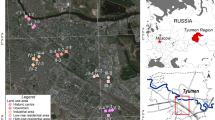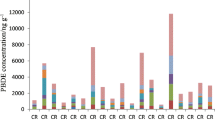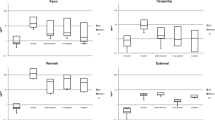Summary
n-Hexane levels were determined by gas chromatography and mass spectrometry in environmental air and in the alveolar air, blood and urine of a group of subjects aged on average of 38 years who had not been occupationally exposed to this hydrocarbon. n-Hexane was found in all environmental air samples examined (n=49), with the mean concentration being 104 ng/l (limit values, 1–279 ng/l). It was also found in all 49 samples of alveolar air, with the mean concentration being 50 ng/l (variation limit, 1–304ng/l). In 64 samples of urine, n-hexane was found in only 50 samples, with the mean concentration being 1,417 ng/l (limit values, 34–8,820 ng/l). In 77 of the 90 blood samples taken, a mean concentration of 608 ng/l was detected (variation limit, 15–7,684ng/l). Particularly the haematic and urinary concentration showed significant differences among the nine groups of individuals classified according to their work activity. The lowest levels were found in the blood and urine of farmers: 270 and 298 ng/l, respectively. The highest values were found for chemical workers (1,377 and 411 ng/1), respectively printers (585 and 2,691 ng/l respectively), and traffic wardens (740 and 8,820 ng/l, respectively). In all, 95% of the determinations of n-hexane yielded values of < 255 ng/l in environmental samples, < 105 ng/l in alveolar air, < 1,475 ng/l in blood and < 5,875 ng/l in urine. A comparison of these data revealed a significant correlation between environmental levels and alveolar (r/s = 0.769; P<0.00001), haematic (r/s = 0.624; P<0.0002), and urinary (r/s = 0.597; P<0.0005) values for n-hexane.
Similar content being viewed by others
References
Brugnone F, Pasini F, Perbellini L, Faccini GB, De Rosa E, Bartolucci GB (1986) Analysis of environmental pollutants in the breath and blood of humans. International Conference on Chemicals in the Environment Proceedings, July 1–3 1986, Lisbon, pp 403–409
Brugnone F, Pasini F, Faccini GB, Danzi B, Perbellini L (1988) Livelli ematici di benzene e di altri idrocarburi nella popolazione urbana normale (in Italian). Con. Naz. su: Inquinamento da Traffico Veicolare e Rischi per la Salute. Pavia, 8 febbraio, pp XIII.1–XIII.12
Brugnone F, Perbellini L, Faccini GB, Pasini F, Maranelli G, Romeo L, Gobbi M, Zedde A (1989a) Breath and blood levels of benzene, toluene, cumene and styrene in non-occupational exposure. Int Arch Occup Environ Health 61:303–311
Brugnone F, Perbellini L, Faccini GB, Pasini F, Maranelli G, Romeo L, Gobbi M, Zedde A (1989b) Benzene in the blood and breath of normal people and occupationally exposed workers. Am J Ind Med 16:385–399
De Bortoli M, Knoppel H, Pecchio E, Peil A, Rogora L, Schauenburg H, Schlitt H, Vissers H (1985) Measurements of indoor air quality and comparison with ambient air: a study on 15 homes in northern Italy. EUR 9656 EN VI. Commission of the European Community, Luxemburg
Fedtke N, Bolt HM (1986) Detection of 2,5-hexanedione in the urine of persons not exposed to n-hexane. Int Arch Occup Environ Health 57:143–148
Frank H, Hintze T, Remmer H (1980a) Volatile hydrocarbons in breath, an indication for peroxidation of lipids. In: Kolb B (ed) Applied head-space gas chromatography. Heyden, London, pp 155–164
Frank H, Hintze T, Bimboes D, Remmer H (1980b) Monitoring lipid peroxidation by breath analysis: endogenous hydrocarbons and their metabolic elimination. Toxicol Appl Pharmacol 56:337–344
Hempel V, May R, Frank H, Remmer H, Köster U (1980) Isobutene formation during halothane anaesthesia in man. Br J Anaesth 52:989–992
Krause C, Mailhan W, Nagel R, Schulz C, Seifert B, Ullrich D (1987) Occurrence of volatile organic compounds in the air of 500 homes in the Federal Republic of Germany. Proceedings, 4th International Conference on Indoor Air Quality and Climate, vol 1. Berlin, August 17–21, pp 102–106
Krotoszynski BK, Bruneau GM, O'Neill HJ (1979) Measurement of chemical inhalation exposure in urban population in the presence of endogenous effluents. J Anal Toxicol 3:225–234
Maranelli G, Perbellini L, Romeo L, Brugnone F (1991) Inquinanti ambientali volatili nei fluidi biologici umani (in Italian). Atti Convegno su: La qualità dell'aria negli ambienti non-industriali. CNR, Rome (in press)
Perbellini L, Tagliaro F, Maschio S, Zedde A, Brugnone F (1986) Dosaggio gas-cromatografico del 2,5-esandione nelle urine (in Italian). Med Lav 77:628–634
Perbellini L, Pasini F, Faccini GB, Danzi B, Gobbi M, Zedde A, Cirillo P, Brugnone F (1988) Determinazione di solventi ad uso industrile nel sangue, nell'aria alveolare e nell'urina di un gruppo di donatori di sangue (in Italian). Med Lav 79:460–467
Pezzagno G, Ghittori S, Imbriani M, Capodaglio E (1985) Eliminazione urinaria dei solventi durante esposizioni controllate: la loro concentrazione urinaria come indicatore biologico di esposizione (in Italian). Atti 48° Cong Naz Soc Ital Medicina del Lavoro e Igiene Industriale Pavia, 18–21 Settembre, pp 511–522
Author information
Authors and Affiliations
Rights and permissions
About this article
Cite this article
Brugnone, F., Maranelli, G., Romeo, L. et al. Ubiquitous pollution by n-hexane and reference biological levels in the general population. Int. Arch Occup Environ Heath 63, 157–160 (1991). https://doi.org/10.1007/BF00381562
Received:
Accepted:
Issue Date:
DOI: https://doi.org/10.1007/BF00381562




